




|
 |
 |
  |
|
 |
| This science module translates the million-mile
of the Genesis spacecraft into an multi-disciplinary travel
module. If you are using Genesis science modules
for
the first time,
read the User's
Guide thoroughly before you begin. (View User's Guide
as aPDF.)
The Portable Document Format (PDF) is used to distribute
fully formatted, print-quality documents electronically.
The following information is available to view and
print as a PDF file with Adobe's Acrobat reader.
To install the FREE Adobe Acrobat Reader, visit the Adobe
Web site.
Take a look at other science
modules available. All technical terms in the
science modules are compiled in the Glossary for
easy access.
Technology
Applications are available for this module.
|
|
  |
 |
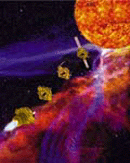
This module takes a thematic approach
to the concept of traveling and destinations. All of
the major disciplines are included in a unit that can
be taught simultaneously in all classes lasting about
one week. The context for this module is the million-mile
journey that the Genesis spacecraft took to LaGrange
point 1, also known as L1. Background information for
this module includes the concept of L1 from a historical
and mathematical perspective. |
 |
|
|
|
|
Adobe's
Acrobat Reader©

The
Portable Document Format (PDF) is used to distribute
fully formatted, print-quality documents. |
|
|
|
|
|
|
|
|
|
|
|
|
 |
|
|
|
|
 |
| This introductory activity will activate
students' prior knowledge about traveling and the preparations
they make to take a trip to a far -away place. Students use the
Internet and travel books to plan a trip. |
|
 |
Curriculum
Connections
Life
Skills Standards Addressed
Grades K-12
Sets and manages goals |
- Sets explicit long-term goals
- Identifies and ranks relevant options in terms of accomplishing
a goal
- Prepares and follows a schedule for carrying out options
- Establishes personal milestones
- Identifies resources necessary to complete a goal
- Makes a cumulative evaluation of goal
- Makes contingency plans
|
Curriculum
Connections
National Science Standards Addressed
Grades 5-12
Science as Inquiry
|
- Understandings about scientific inquiry
|
| Physical Science |
|
|
| Earth and Space
Science |
- Earth in the Solar System
|
Grades
5-8
History and Nature of Science
|
|
|
Grades
9-12
History and Nature of Science
|
|
|
Curriculum
Connections
National
Mathematics Standards Addressed
Grades 6-8
Numbers and Operations
|
- Understand numbers, ways of representing numbers, relationships
among numbers and number systems
- Understand meanings of operations and how they relate
to one another
- Compute fluently and make reasonable estimates
|
| Algebra |
- Use mathematical models to represent and understand quantitative
relationships
- Represent and analyze mathematical situations and structures
using algebraic symbols
|
Grades
9-12
Algebra
|
- Understand patterns, relations and functions
- Represent and analyze mathematical situations and structures
using algebraic symbols
|
Grades
6-8
Geometry
|
- Analyze characteristics and properties of two- and three-dimensional
geometric shapes and develop mathematical arguments about
geometric relationships
- Use visualization, spatial reasoning, and geometric modeling
to solve problems
|
Grades
9-12
Geometry
|
- Analyze characteristics and properties of two- and three-dimensional
geometric shapes and develop mathematical arguments about
geometric relationships
- Specify locations and describe spatial relationships
using coordinate geometry and other representational systems
|
Grades
5-12
Problem Solving
|
- Solve problems that arise in mathematics and in other
contexts
|
| Connections |
- Recognize and apply mathematics in contexts outside of
mathematics
|
Curriculum
Connections
National
History Standards Addressed
Grades 5-8
Historical Understanding
|
- Understands and knows how to analyze chronological relationships
and patterns
- Understands historical perspective
|
Curriculum
Connections
National
Geography Standards Addressed
Grades K-12
The World in Spatial Terms
|
- Understands the characteristics and uses maps, globes,
and other geographic tools and technologies
|
Curriculum
Connections
National
Economic Standards Addressed
Grades K-12
Economics Standard and Benchmarks
|
- Understands that scarcity of productive resources requires
choices that generate opportunity costs
|
Curriculum
Connections
National
Language Arts Standards Addressed
Grades 3-12
Reading |
- Uses the general skills and strategies for the reading
process
- Uses reading skills and strategies to understand and
interpret a variety of literary texts
- Uses reading skills and strategies to understand and
interpret a variety of informational texts
|
| Listening and
Speaking |
- Uses listening and speaking strategies for different
purposes
|
Curriculum
Connections
National
Science Standards Addressed
Assessment Standard B
|
- Achievement and Opportunity to Learn Science must be
Assessed
|
| Assessment Standard
C |
- Assessment Tasks Are Authentic
|
|
|
|
|
|
|
 |
|
|
|
|
|
The science activities in this
module deal with the concept of travel as it relates to natural
objects (planets) traveling around the sun. The activities are
designed to let the students discover Kepler's Laws of Planetary
Motion by completing assignments about the laws.
In the first activity, "Round and Round," students
are given some historical context by reading background information
about Nicolaus Copernicus, Tycho Brahe, and Johannes Kepler.
Students then construct an ellipse using two different methods.
They discover that planets orbit around the sun in elliptical
orbits (first law). Using one of these ellipses, students are
introduced to the concepts of the focus and the semi-major
axis of an ellipse. Using these concepts, they determine the
eccentricity of an ellipse and compare this with the relative
roundness of the planetary orbits.
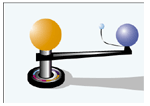 In
the second activity, "Sweepstakes," students learn
that as a planet travels around the sun, at different points
it sweeps out equal areas in equal times (second law). In
the second activity, "Sweepstakes," students learn
that as a planet travels around the sun, at different points
it sweeps out equal areas in equal times (second law).
In the third activity, "The Inclined Pendulum," using
a simulation, students model the fact that a decrease in gravity
causes a decrease in orbital velocity and those more distant
planets revolve around the sun at slower velocities (third
law).
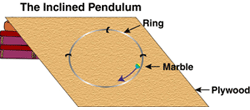
Finally, the students conclude by reading the Student Text, "L1
or Bust." They learn about the LaGrange Points and study the trajectory
that is used by the Genesis spacecraft.
|
|
|
|
|
|
|
|
|
|
|
In "Minimum Energy Transfer
Orbits," students will study the mathematics involved in
having a spacecraft move from one orbit to another. They will
use a mathematical formula derived from Kepler's Third Law of
Motion (see "The Inclined Pendulum") to calculate the
time of flight that a spacecraft would take to travel from Earth
to another planet in our solar system using the minimum amount
of energy. Students will look at the formula derived from Kepler's
Third Law and make some simple calculations. Once students have
calculated time of flight to one or more planets, they can use
an Excel spreadsheet to investigate other transfer orbits as
a technology application. 
Using a surprisingly simple relationship, Kepler's Third Law, we can
study the orbit of a spacecraft about a body in space. We can study the
basic parameters of (1) the time our spacecraft will take to circle the
body once (called the "Period") and (2) its average distance
from the body (we will call this "A"). Kepler came up with
this law in 1619 after having spent the previous 19 years studying the
best data on the orbit of Mars. This equation is empirical, that is,
based on the very careful analysis of data.
|
|
|
|
|
|
|
|
|
|
|
| LaGrangian points are named after
their discoverer, Joseph-Louis LaGrange, a French mathematician.
Considered the greatest mathematician of his time, LaGrange mathematically
discovered five special points in the vicinity of two orbiting
masses where the combined gravitational forces are zero. In this
activity, students study the life of LaGrange and create a sequence
map of the important events in his life.
 In "Where
on Earth?" students review the concepts of latitude and
longitude and use maps to determine latitude and longitude
for several cities and the destinations they chose in "What
a Trip!" In "Where
on Earth?" students review the concepts of latitude and
longitude and use maps to determine latitude and longitude
for several cities and the destinations they chose in "What
a Trip!"
In "What a Choice," students calculate the cost
for each resource and develop a budget for the trip. They will
also identify the choices they made in planning their trip
and preparing the budget.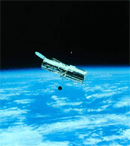
|
|
|
|
|
|
|
|
|
|
 |
 |
Destitute Gulch,
www.sci-fi.ch and Universal Pictures |
The language arts activities in this module focus on an understanding
of the science fiction genre as it functions in literature, on
reading comprehension, and basic writing strategies. The communication
activities center around two strands of communication: verbal and
non-verbal.
A technology communication theme that deals with both strands
will also be utilized. Both disciplines use two short stories
by Ray Bradbury that function as springboards for these activities.
The first is "Golden Apples of the Sun," and the second
is "The Wilderness."
Both stories are rich with opportunities to develop students'
critical thinking and communication/language arts skills; both
stories have a strong science application that advance science
inquiry processes.
Before they begin, students will be asked to provide their own
definitions of communication-a seemingly easy task that soon
becomes complicated and always results in a spirited classroom
discussion.
|
|
|
|
|
|
|
|
|
|
|
|
|
| This activity engages students in
preparing a travelogue, selecting the most appropriate means of
presentation to share their school travel experiences with the
class. |
|
|
|
|
|
|
|
|
|
|
|
|
|
|
Read about Martin Lo, a JPL engineer
who applies "chaos theory" to design trajectories like
the one used by Genesis, using his LTool which has defined what
he 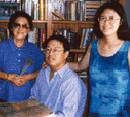 calls "'InterPlanetary
Superhighway':paths through space that depend on balanced-gravity
points between planets." calls "'InterPlanetary
Superhighway':paths through space that depend on balanced-gravity
points between planets." |
|
|
|
|
|
|
 |
|
|
|
|
 |
|
|
|
|
|
|
|
|
 |
|
|
|
|
| Writers: |
~Dr. Mike Arnold,
McREL
~Jacinta Behne, McREL
~John Ristvey, McREL
~Dr. Gil Yanow, JPL
~Merrie Sasaki, Consultant
|
| Technical Editors: |
~Susanne Chastain,
McREL
~Jacinta Behne, McREL
|
|
| Graphics: |
~Judy Counley, McREL
|
| Layout: |
~Juli Pennock, McREL
|
| Special thanks to the following reviewers: |
~Dr. Donna Bogner, McREL
~Greg Rawls, McREL
~Dr. Gil Yanow, Jet Propulsion Laboratory
|
|
|
|
|
|
|
|
|
|
|
|
|
|
|
|
